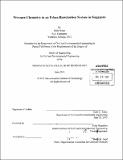Nitrogen chemistry in an urban bioretention system in Singapore
Author(s)
Ritter, Halle (Halle Caitlan)
DownloadFull printable version (10.56Mb)
Other Contributors
Massachusetts Institute of Technology. Department of Civil and Environmental Engineering.
Advisor
Peter Shanahan.
Terms of use
Metadata
Show full item recordAbstract
An investigation into the nitrogen chemistry of the anoxic layer of an urban constructed wetland in Singapore was conducted. This pilot-scale wetland treats stormwater runoff from the Balam Estate housing development for several water quality parameters of concern, including nitrate. Earlier sampling in the wetland had indicated that the concentration of nitrate was lower in the outflow from the rain garden than in its inflow, but no research had been done on other nitrogen species or transformation pathways. Preliminary analyses suggest that, although the saturated layer is sufficiently anoxic and denitrification is occurring as per performance objectives, organic nitrogen is being added to the infiltrating water throughout this layer, causing a net export of total nitrogen from the anoxic zone. This organic nitrogen could be either re-released from reserves adsorbed onto organic material during previous storm events, or leached directly from the anoxic layer material which includes wood chips and sand. Readings at outflow pipes indicate that a percentage of this nitrogen is likely re-mineralizing to ammonia upon exposure to more oxygen-rich conditions in the outflow pipes. Further study in the Balam Rain Garden using isotope labeling to more clearly delineate nitrogen fate and transport is suggested.
Description
Thesis (M. Eng.)--Massachusetts Institute of Technology, Department of Civil and Environmental Engineering, 2013. Cataloged from PDF version of thesis. Includes bibliographical references (pages 35-37).
Date issued
2013Department
Massachusetts Institute of Technology. Department of Civil and Environmental EngineeringPublisher
Massachusetts Institute of Technology
Keywords
Civil and Environmental Engineering.